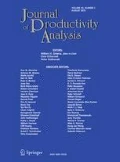Abstract
In this paper we model production technology in a state-contingent framework. Our model analyzes production under uncertainty without being explicit about the nature of producer risk preferences. In our model producers’ risk preferences are captured by the risk-neutral probabilities they assign to the different states of nature. Using a state-general state-contingent specification of technology we show that rational producers who encounter the same stochastic technology can make significantly different production choices. Further, we develop an econometric methodology to estimate the risk-neutral probabilities and the parameters of stochastic technology when there are two states of nature and only one of which is observed. Finally, we simulate data based on our state-general state-contingent specification of technology. Biased estimates of the technology parameters are obtained when we apply conventional ordinary least squares estimator on the simulated data.



Similar content being viewed by others
Notes
Producers risk attitudes can be captured by the shape of their ex post utility function.
The input in CES functional form is state general.
Only one of the two possible state-contingent outputs is observed.
This state-contingent production function closely resembles the conventional multi-input and single output CES production function. In conventional representation of CES production function, the output produced is expressed as a function of multiple input used in the production process. In the CES type state-contingent production function given by (1) the total input applied to the production process is expressed as a function of state-contingent outputs.
This is the definition given by Chambers and Quiggin (2000).
The modelling presented in this section is an extension of O'Donnell and Shankar (2010).
Also the inputs allocated to each of the two states of nature are unobserved, irrespective of whether the technology is state-allocable or state-general.
First \(\ln (q)\) is regressed on state dependant constants and \(\ln (x)\) and state dependant constants c 1 and c 2 are estimated along with coefficient (c 3) of \(\ln (x)\). Then, a 1 and a 2 are derived using the transformation \(a_1 = \exp ({- {c_1} /{c_3}})\) and \(a_2 = \exp ({-{c_1}/ {- {c_2}{c_3}}})\) respectively. Finally the standard errors for a 1 and a 2 are computed using delta method.
This result should not come as a surprise because the data was generated using this CES specification and there was no noise added to the data.
In this case the input is a function of the two state-contingent outputs and the functional form is Cobb–Douglas.
References
Arrow KJ, Chenery HB, Minhas BS, Solow RM (1961) Capital-labour substitution and economic efficiency. Rev Econ Stat 43:225–250
Chambers RG, Quiggin J (2000) Uncertainty, production, choice and agency: the state-contingent approach. Cambridge University Press, Cambridge
Chavas JP (2008) A cost approach to economic analysis under state-contingent production uncertainty. Am J Agric Econ 90(2):435–446
Hardy G, Littlewood J, Polya G (1934) Inequalities. Cambridge University Press, Cambridge
O’Donnell CJ, Griffiths WE (2006) Estimating state-contingent production frontiers. Am J Agric Econ 88(1):249–266
O’Donnell CJ, Chambers RG, Quiggin J (2010) Efficiency analysis in the presence of uncertainty. J Prod Anal 33:1–17
O'Donnell CJ, Shankar S (2010) Estimating State-allocable Production Technologies When there are two States of Nature and State Allocations of Inputs are Unobserved. Centre for Efficiency and Productivity Analysis Working Papers WP04/2010. University of Queensland
Acknowledgments
We wish to acknowledge two anonymous referees whose constructive comments considerably improved an earlier version of this article. The usual caveat applies.
Author information
Authors and Affiliations
Corresponding author
Rights and permissions
About this article
Cite this article
Shankar, S., Quiggin, J. Production under uncertainty: a simulation study. J Prod Anal 39, 207–215 (2013). https://doi.org/10.1007/s11123-012-0281-3
Published:
Issue Date:
DOI: https://doi.org/10.1007/s11123-012-0281-3




